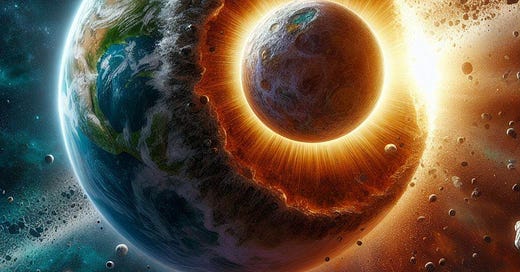Risk & Progress| A hub for essays that explore risk, human progress, and your potential. My mission is to educate, inspire, and invest in concepts that promote a better future. Subscriptions are free, paid subscribers gain access to the full archive, including the Pathways of Progress and Realize essay series.
If we could explore all of the universe's planets, what would we find on them? Would we encounter endless dead rocks floating in the abyss, or planets teeming with life? Would we need to confront life that is more advanced than us? Or is the universe filled with ruins, like Rome or Greece today, of complex civilizations that have long since perished? As we have explored thus far, the evidence suggests that our existence as sentient molecules on this planet is fortuitous and something to be appreciated and safeguarded.
To the best of our knowledge, the universe began some 13.8 billion years ago with the ‘Big Bang.’ Before that moment, per our current understanding at least, nothing existed. Everything that would ever be was compressed into an unimaginably small space, a ‘gravitational singularity’ far smaller than an atom. So dense that it infinitely curved space-time, such that the concept of time didn’t even exist. Within the singularity, the four fundamental forces we know today (the weak nuclear force, electromagnetism, strong nuclear force, and gravity) were equivalent in strength and probably unified into a single fundamental force.
This singularity suddenly and inexplicably burst outward. In the first second of the universe’s existence, the concepts we call time, space, and the laws of physics emerged. In the following seconds, subatomic particles (quarks, electrons, neutrinos, etc) began to form, then larger particles like positively charged protons. Neutrons were formed by the collision of negatively charged electrons and protons under these extreme conditions. By about 3 minutes after birth, the universe had cooled just enough to allow those larger particles to fuse, creating the first simple nuclei, the cores of hydrogen and helium atoms.
After about 20 minutes of rapid expansion, the nascent universe was no longer hot enough to sustain fusion, leaving the universe as a hot soup of electrons, hydrogen, and helium nuclei. The opaque plasma soup continued expanding and cooling. After about 300 thousand years, it had finally cooled enough to allow early hydrogen and helium nuclei to capture electrons, neutralizing their charge and making the universe transparent to light for the first time. Despite this, the universe remains a completely dark “fog,” with no stars yet formed to give off light. Everything remained in total darkness for another 150 million years until minute imperfections and irregularities in matter density allowed gravity to pull atoms together into clumps.
As these gases pulled together, they began to collapse under their gravity, becoming hot enough to restart the fusion process of the early universe. When this happened, it ignited the first stars; light had finally come. These early stars were 100 times the mass of our Sun, dying quickly and exploding into supernovas that scattered matter across a growing universe. That matter formed the basis of new, smaller stars over the next few hundred million years; furnaces that would produce more complex and heavier elements, like iron, nickel, and carbon. It was also around this time that stars gathered together in rotating spiral formations that we now call galaxies.
It would be about 9 billion years after the Big Bang before our Sun and Solar System began to form. The Sun gobbled up most of the matter for itself, leaving just a spinning disk of debris around it. Clumps of this debris would pull together and become the planets. These early proto-planets competed with one another for slots around the new star. The early Solar system was violent, with frequent impacts between objects, ranging from specks of dust to collisions between the proto-planets themselves. Our Moon is thought to have formed when a Mars-sized planet collided with an early Earth, ejecting a significant portion of our own planet into orbit.
We know this because exploration of the Moon has retrieved rocks for study. From the Moon’s mantle, Basaltic rocks are eerily similar to those from the Earth. Oxygen isotopes sealed into those rocks also closely match terrestrial counterparts, far too precisely to be a coincidence. Yet, the scale of such a collision is almost beyond comprehension. It is too bad no one was around to witness it.
A Fortuitous Planet
There is nothing particularly special about the Earth or the Solar System. We now know that there are tens of billions of planets like the Earth in the universe. Yet, I argue that our placement on this planet is still fortuitous. Earth sits in the middle of the Sun’s so-called “habitable zone” where temperatures are ‘just right’ for the formation of liquid water, a prerequisite for life as we know it. Also, from its inception, Earth had access to heavier elements born of extinct stars, namely carbon. This is why I subscribe to the belief that the most probable solution to Fermi’s Paradox is that life emerged on Earth relatively early.
All life on Earth is carbon-based, which is a probabilistic consequence of the characteristics of carbon itself. Carbon readily bonds with itself and other elements, allowing the formation of complex molecules, including DNA and proteins. This is because carbon has 4 valence electrons and is uniquely able to form strong, yet pliable bonds with other elements; perfect for life, which must maintain enough structure to counter entropy, but be adaptable enough to evolve, grow, and change. Also, unlike Venus, Mars, or Mercury, Earth has a powerful magnetosphere that shields us from the Solar wind. Without it, our atmosphere would be eroded by the Sun, and life would be constantly exposed to harmful radiation.
Today, we humans may also feel fortunate that the gravity well of our planet does not trap us on the surface. Already, our rockets are pressing upon the limits of physics to escape Earth's gravity, using over 95 percent of their mass to reach orbit, with only five percent left for a useful payload. Had the Earth been more massive, it would be vastly more difficult for us to explore space. Yet, any less massive, and it may not have been able to hold a sufficient atmosphere for us to breathe. We might also feel fortunate for Moon. Rich in water and Earthly elements due to its shared history, the Moon is distant enough from Earth that it poses no risk to life, but close enough that it could serve as a proving ground for human planetary exploration, or a proverbial “gas station” to refuel on the way other locations in the Solar System. None of the rocky planets orbiting the Sun can claim a Moon remotely like ours.
It’s difficult to comprehend how many variables on Earth came together at just the right time to form and sustain life. This incredible string of happy coincidences makes one wonder if we are indeed living in some kind of simulation intended to study the emergence of intelligent life. In the vastness of the universe, however, there are probably countless planets with similar fortuitous conditions. Nonetheless, we are lucky to be here on the pale blue dot. Next, we examine how and why life may have sprung from otherwise lifeless matter.
You also may like…







There are other "fortuitous" facts as well. only for certain critical values of the strong nuclear force and other parameters will Helium fused from primordial Hydrogen fuse into useful-to-life Carbon and then Carbon to Oxygen Here is a fun link https://faculty.wcas.northwestern.edu/infocom/The%20Website/index.html
Sean Carrollof Mindscape podcast talks lot about cosmologlogy, the anthropic principle, etc. Anyo who likes this post will like lots of Mindscape. :)